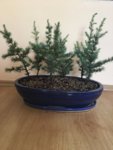@dani Will you please bear with me if I take the opportunity to ask Osoyoung a few questions on the matter and get educated!

1) Do you consider the role which the age of tree plays in the recovery process to be of importance?
Or there is not a difference whether the material is aged or young?
There is some decline in the ability to generate new tissues with age, for the most part, 'old' just means 'bigger'. Some species loose the ability to generate adventitious roots from stems (i.e., root as cuttings/layers) with age. But the physiology of generating more roots from root tissue is pretty much invariant with age. Most adsorption of water and minerals occurs from extensions of the wall of individual cells on the surface of the roots just behind the (usually white colored) growing tip. Roots are dead when this doesn't happen and the tree is dead shortly after this is generally the case. So, for any healthy tree, no age doesn't matter.
@dani2) You suggest to repot circa August -> when new growth has hardened.
At my place new growth would be hardened a lot more earlier than August.
If I repot after that, the tree with its injured roots will go through temp. 35-40C and almost completely dry atmosphere.
When do you think it would be optimum for my conditions to repot a Cedar ?
Optimal root growth occurs at temperatures in the range of 15C to 20C because of a combination of the solubility versus diffusivity of oxygen in water. Above roughly 30C, roots don't grow. Roots die in temperatures approaching and above 45C. This is why I've encouraged people to buy a cheap meat thermometer probe and to stick it in the pot among the roots to see what temperatures the roots are actually experiencing - about $15US is all it takes. The single most effective way to keep the roots cool is to bathe them in cold water. Water has a huge heat capacity (meaning it takes a lot of energy to make water's temperature rise one degree). So, we never want the substrate to go dry - the temperature will soar and cook roots! We must let in oxygen, so all we can do is to limit evaporation from the substrate by covering it with something like damp sphagnum or a damp towel and/or reduce the energy input by covering the pot and all with a damp/reflective material. With a trusty thermometer probe anyone can figure out what works for them, in their location, in their climate, anytime one wants to know. All functioning root tips are new. Root hairs (those extensions of the wall of single cells) last only about a week, even though they are continually being generated and lost.
The problem you've recognized, though, is that one reduces the number of growing root tips when pruning roots and, hence, for a week or two affected a (possibly) serious reduction in the capacity for the tree to take on water. You are correct that low relative humidity makes for high water demand (transpiration). Most conifers (certainly including Atlas cedar) have a waxy cuticle that doesn't pass much water, so they very effectively limit their water demand by closing the leaf stomata. Growing roots requires auxin and food to grow on = carbohydrates from the photosynthesis. Most conifers do this poorly in shade.
The productivity of leaves (in terms of auxin and carbohydrate production) declines with age. In the spring much of the stored carbohydrates has been consumed extending the new growth and auxin in the pipeline to the roots has been depleted (because of its use in the cambium to produce new wood to support the needs of all that new growth). Within a week or two, leaves sense the passage of the summer solstice and there is a big switch in tree growth patterns. The rate of radial growth that was accelerating day by day now slows day by day. A steady flow of auxin becomes available to the roots and they also get their share of all that new high-rate carbohydrate productivity up above. In simpler words, trees have a high capacity to recover from root pruning after the summer solstice.
I say 'circa August' for the sake of giving some time for building strength (carbohydrate storage) before diving in AND ample time to strengthen afterward, before winter dormancy. I believe the window of 'good to go' for repotting runs from mid July to the time temperatures drop below 5C. One just wants to not mess with roots 4 to 6 weeks before temperatures are below freezing for extended periods of time. Adjust the time to July or Sep/Oct/Nov as the constraints of your climate dictate. Trees 'harden' for winter by 'sugaring up' and drying their tissues. It is a process driven by exposure to progressively lower temperature excursions, typically overnight 'frosts'. Sudden excursions from temperatures above 5C to below -5C (or wider) tend to be damaging to all trees. Anecdotally, such sudden, hard freezes are more so to newly pruned roots.
Okay. Sorry that you asked?
wink, wink
nod, nod

